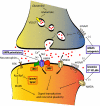From synapse to nucleus: novel targets for treating depression
- PMID: 20018197
- PMCID: PMC2821954
- DOI: 10.1016/j.neuropharm.2009.12.004
From synapse to nucleus: novel targets for treating depression
Abstract
The need for newer compounds to treat depression is an ever-growing concern due to the enormous societal and financial ramifications of this disorder. Here, we review some of the candidate systems that could potentially be involved in depression, or an inherent resistance to depression termed resilience, and the numerous protein targets for these systems. A substantial body of literature provides strong evidence that neurotrophic factors, glutamate receptors, hypothalamic feeding peptides, nuclear hormone receptors, and epigenetic mechanisms, among others, will make for interesting targets when examining depressive behavior or resilience in preclinical models, and eventually clinical trials. Although some of these targets for depression already appear promising, new waves of more selective compounds for any molecular system should promote a better understanding of this complex disease and perhaps improved treatments.
Copyright 2009 Elsevier Ltd. All rights reserved.
Figures


Similar articles
-
GABA and glutamate systems as therapeutic targets in depression and mood disorders.Expert Opin Ther Targets. 2005 Feb;9(1):153-68. doi: 10.1517/14728222.9.1.153. Expert Opin Ther Targets. 2005. PMID: 15757488 Review.
-
The missing link between clinical endpoints and drug targets in depression.Trends Pharmacol Sci. 2010 Apr;31(4):144-52. doi: 10.1016/j.tips.2009.12.004. Epub 2010 Feb 1. Trends Pharmacol Sci. 2010. PMID: 20117847
-
Reshaping the Depressed Brain: A Focus on Synaptic Health.Biol Psychiatry. 2018 Dec 1;84(11):e73-e75. doi: 10.1016/j.biopsych.2018.09.028. Biol Psychiatry. 2018. PMID: 30409269 Free PMC article. No abstract available.
-
Advances in novel molecular targets for antidepressants.Prog Neuropsychopharmacol Biol Psychiatry. 2021 Jan 10;104:110041. doi: 10.1016/j.pnpbp.2020.110041. Epub 2020 Jul 16. Prog Neuropsychopharmacol Biol Psychiatry. 2021. PMID: 32682872 Free PMC article. Review.
-
Targeting the Neuronal Activity of Prefrontal Cortex: New Directions for the Therapy of Depression.Curr Neuropharmacol. 2020;18(4):332-346. doi: 10.2174/1570159X17666191101124017. Curr Neuropharmacol. 2020. PMID: 31686631 Free PMC article.
Cited by
-
Epigenetic mechanisms in mood disorders: targeting neuroplasticity.Neuroscience. 2014 Apr 4;264:112-30. doi: 10.1016/j.neuroscience.2013.01.041. Epub 2013 Jan 30. Neuroscience. 2014. PMID: 23376737 Free PMC article. Review.
-
SIRT1 Mediates Depression-Like Behaviors in the Nucleus Accumbens.J Neurosci. 2016 Aug 10;36(32):8441-52. doi: 10.1523/JNEUROSCI.0212-16.2016. J Neurosci. 2016. PMID: 27511015 Free PMC article.
-
JNK Regulation of Depression and Anxiety.Brain Plast. 2018 Aug 10;3(2):145-155. doi: 10.3233/BPL-170062. Brain Plast. 2018. PMID: 30151339 Free PMC article. Review.
-
Gene expression patterns in the hippocampus and amygdala of endogenous depression and chronic stress models.Mol Psychiatry. 2012 Jan;17(1):49-61. doi: 10.1038/mp.2010.119. Epub 2010 Nov 16. Mol Psychiatry. 2012. PMID: 21079605 Free PMC article.
-
Experimental psychiatric illness and drug abuse models: from human to animal, an overview.Methods Mol Biol. 2012;829:31-48. doi: 10.1007/978-1-61779-458-2_2. Methods Mol Biol. 2012. PMID: 22231805 Free PMC article. Review.
References
-
- Aan Het Rot M, Collins KA, Murrough JW, Perez AM, Reich DL, Charney DS, Mathew SJ. Safety and efficacy of repeated-dose intravenous ketamine for treatment-resistant depression. Biol Psychiatry. 2009 in press. - PubMed
-
- Ahokas A, Kaukoranta J, Wahlbeck K, Aito M. Estrogen deficiency in severe postpartum depression: successful treatment with sublingual physiologic 17beta-estradiol: a preliminary study. J Clin Psychiatry. 2001;62:332–336. - PubMed
-
- Alt A, Weiss B, Ornstein PL, Gleason SD, Bleakman D, Stratford RE, Jr., Witkin JM. Anxiolytic-like effects through a GLUK5 kainate receptor mechanism. Neuropharmacology. 2007;52:1482–1487. - PubMed
-
- Bacchi F, Mathe AA, Jimenez P, Stasi L, Arban R, Gerrard P, Caberlotto L. Anxiolytic-like effect of the selective neuropeptide Y Y2 receptor antagonist BIIE0246 in the elevated plus-maze. Peptides. 2006;27:3202–3207. - PubMed
Publication types
MeSH terms
Substances
Grants and funding
LinkOut - more resources
Full Text Sources
Medical

